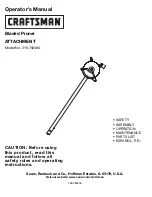
34 | GB
13. Disposal and recycling
The equipment is supplied in packaging to prevent it
from being damaged in transit. The raw materials in
this packaging can be reused or recycled.
The equipment and its accessories are made of vari-
ous types of material, such as metal and plastic. De-
fective components must be disposed of as special
waste. Ask your dealer or your local council.
Old devices must not be disposed of with house-
hold waste!
This symbol indicates that this product must not
be disposed of together with domestic waste in
compliance with the Directive (2012/19/EU)
pertaining to waste electrical and electronic
equipment (WEEE). This product must be disposed of
at a designated collection point. This can occur, for
example, by handing it in at an authorised collecting
point for the recycling of waste electrical and electron-
ic equipment. Improper handling of waste equipment
may have negative consequences for the environ-
ment and human health due to potentially hazardous
substances that are often contained in electrical and
electronic equipment. By properly disposing of this
product, you are also contributing to the effective use
of natural resources. You can obtain information on
collection points for waste equipment from your mu-
nicipal administration, public waste disposal authority,
an authorised body for the disposal of waste electrical
and electronic equipment or your waste disposal com-
pany.
Batteries and rechargeable batteries do not be-
long in the household waste!
As the consumer you are required by law to
bring all batteries and rechargeable batteries,
regardless whether they contain harmful sub-
stances* or not, to a collection point run by the local
authority or to a retailer, so that they can be disposed
of in an environmentally friendly manner.
*labelled with: Cd = cadmium, Hg = mercury, Pb =
lead
Remove the batteries from the laser before disposing
of the machine and the batteries.
Damaged electrical connection cable.
The insulation on electrical connection cables is often
damaged.
This may have the following causes:
• Passage points, where connection cables are
passed through windows or doors.
• Kinks where the connection cable has been improp-
erly fastened or routed.
• Places where the connection cables have been cut
due to being driven over.
• Insulation damage due to being ripped out of the
wall outlet.
• Cracks due to the insulation ageing.
Such damaged electrical connection cables must not
be used and are life-threatening due to the insulation
damage.
Check the electrical connection cables for damage
regularly. Make sure that the connection cable does
not hang on the power network during the inspection.
Electrical connection cables must comply with the ap-
plicable VDE and DIN provisions. Only use connec-
tion cables with the marking „H05VV-F“.
The printing of the type designation on the connection
cable is mandatory.
If the power cord of this device is damaged, it must
be replaced by the manufacturer, their service depart-
ment or a similarly qualified person to avoid dangers.
AC motor:
The mains voltage must be 220 - 240 V~.
• Extension cables up to 25 m long must have a
cross-section of 1.5 mm
2
.
• Connections and repairs of electrical equipment
may only be carried out by an electrician.
Please provide the following information in the event
of any enquiries:
• Type of current for the motor
• Machine data - type plate
Summary of Contents for 3901105851
Page 2: ...2 ...
Page 4: ...4 6 8a 8b 22 8 27 28 7 8 11 33 34 12 36 35 36 B 22 22a 10 29 30 5 6 9 32 23 4 13 37 31 12 ...
Page 5: ...5 15 14 F F F F ...
Page 98: ...98 ...
















































